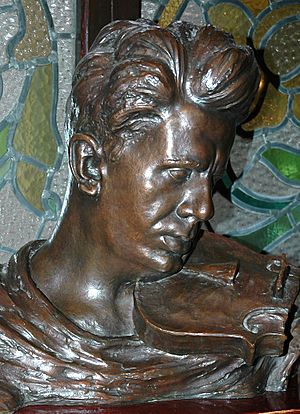Eduard Toldrà facts for kids
Eduard Toldrà Soler (born April 7, 1895, in Vilanova i la Geltrú – died May 31, 1962, in Barcelona) was a famous Catalan composer and conductor from Spain. He was known for his beautiful music and for leading orchestras.
Contents
Eduard Toldrà: A Catalan Music Master
Eduard Toldrà played a very important part in the music scene in Barcelona. In 1944, he started the Barcelona Symphony Orchestra at the amazing Palau de la Música Catalana. This is a famous concert hall. Later, in 1957, his friend Ricardo Lamote de Grignon became his assistant there. Toldrà also often helped judge the Maria Canals International Music Competition, a big music contest. Some of his students, like Antoni Ros-Marbà and Xavier Montsalvatge, also became famous musicians.
Eduard Toldrà's personal notes and papers are kept safe at the Biblioteca de Catalunya, a library in Catalonia.
What Kind of Music Did He Create?
Eduard Toldrà wrote many different kinds of music. His songs are often described as short, simple, and very warm, sometimes sounding like popular city music.
Music for Plays and Shows
This type of music is written to go along with plays or other performances.
- 1928: El giravolt de maig (The May Sunflower) – This was a funny opera, which is like a play where people sing instead of speak.
Chamber Music
Chamber music is written for a small group of instruments, usually played in a smaller room or "chamber."
- 1914: Quartet in C minor – This was for a string quartet, which is a group of four string instruments (like violins and cellos).
- 1920: Vistes al mar (Sea Views) – Also for a string quartet, but later it was arranged for a slightly larger group called a chamber orchestra.
- 1921: Six sonnets – Written for violin and piano. One part, Ave Maria, was also made into a piece for a full orchestra.
Music for Full Orchestras
This is music written for a large group of musicians playing many different instruments together.
- 1919: Suite in E Major
- 1926: Empúries – This piece was like an invitation to a beautiful area called Empordà.
- 1930: La maledicció del comte Arnau (The Curse of Count Arnau) – A dramatic piece for orchestra.
Songs
Toldrà wrote many songs, usually for a singer with piano music, but sometimes with an orchestra.
- 1924: Vinyes verdes vora el mar (Green vineyards by the sea) – A very popular song.
- 1927: Garba – This was a collection of six songs that won a prize.
- 1936: La rosa als llavis (The rose to the lips) – A song for voice and orchestra that also won an award.
- 1958: Cançó per a fer dormir l'Eduard i Villancet – A song he wrote to help his family sleep.
Sardanes
A Sardana is a traditional Catalan folk dance. Toldrà wrote many pieces specifically for this dance, often for brass instruments.
- 1917: Sol ponent (Setting sun)
- 1919: Marinera (The sailor)
- 1921: Lluna plena (Full moon)
- 1925: La fageda d'en Jordà (The Jordan fig tree)
- 1930: Tamariu
- 1935: Perafita i Capvespre (Sunset at Perafita)
Many of Eduard Toldrà's works are published by a company called La Mà de Guido.
Toldrà as a Conductor
Besides composing, Eduard Toldrà was also a talented conductor. He led many musical performances.
- One of his famous recordings as a conductor is El retablo de maese Pedro.
See also
 In Spanish: Eduard Toldrà para niños
In Spanish: Eduard Toldrà para niños


